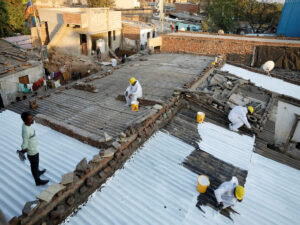
Ahmedabad, one of India’s hottest cities, is implementing innovative measures such as cool roofs, misting bus stops, and heat insurance to tackle the worsening impacts of extreme heat. However, the benefits of these solutions remain limited, especially for low-income residents.
After a deadly heatwave in 2010 that killed 1,344 people, Ahmedabad became the first Indian city to introduce a Heat Action Plan (HAP). The plan aims to protect residents from rising temperatures, but the challenges of implementation persist, particularly in the city’s informal settlements.
A study by the Centre for Science and Environment (CSE) shows that over 95% of Ahmedabad’s land is heat-stressed, with surface temperatures crossing 45°C regularly. Areas like Odhav, where informal settlements have grown under metal and tin-sheet roofs, are especially vulnerable.
For many residents, such as Sushma Mishra—a handicraft worker in Odhav—the heat is not just uncomfortable but dangerous. Her tin-roofed house traps the heat, turning her home into an oven. With daily incomes of ₹400-500, investing in cooling solutions like air conditioning is impossible, and even fans are a luxury for some.
Civil society groups like the Mahila Housing Trust (MHT) are working to bridge this gap. MHT has introduced cool roofs coated with reflective white paint to lower indoor temperatures. This initiative has received positive feedback and is now part of the city’s official Heat Action Plan.
Another solution being tested is heat insurance—a parametric product that offers automatic payouts when temperatures cross specific thresholds. Beneficiaries receive ₹750 when the temperature exceeds 43.7°C for two consecutive days and ₹1,250 when it goes beyond 44.1°C. However, the annual premium of ₹354 remains unaffordable for many, and awareness of such schemes is still low.
To spread awareness, MHT has held interactive sessions and games to teach women the importance of heat protection. The idea is slowly gaining acceptance, though uptake remains limited.
The city has also set up Cool Bus Stops equipped with misting systems, which reduce the ambient temperature by 4–7°C. These stops provide much-needed relief to commuters waiting in the scorching sun. Installed at busy points like Lal Darwaza, the misting system operates from 11:30 am to 5:30 pm daily.
Ahmedabad’s older neighbourhoods also offer lessons in heat resilience. Traditional housing clusters, or ‘pols’, are built with narrow lanes and thick walls that naturally reduce heat buildup. Blue spaces like Kankaria Lake, Vastrapur, and the Sabarmati Riverfront continue to offer public relief, with families gathering there during the evenings to escape the day’s heat.
Yet for many, such as Sushma Mishra and other low-income residents, these collective solutions offer little immediate relief. Distance, cost, and daily survival needs keep them from accessing these cooling spaces, leaving them to struggle against the heat in silence.
As Ahmedabad’s population grows and temperatures rise, scaling up these climate resilience measures and ensuring they reach the most vulnerable remains a key challenge for the city.
